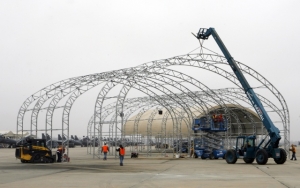4th Fighter Wing builds shelters to protect its Strike Eagle fleet
By Kenneth Fine
Published in News on December 17, 2008 1:46 PM

News-Argus/MITCH LOEBER
Construction is underway on new shelters for Seymour Johnson Air Force Base's F-15E fleet.
Less than a month after Air Force Chief of Staff Gen. Norton Schwartz suggested the F-15E would be a viable airframe for another decade or more, crews at Seymour Johnson Air Force Base are working to protect the 4th Fighter Wing's Strike Eagle fleet.
Six shelters recently obtained from Cannon Air Force Base in New Mexico are currently being assembled on the Seymour flight line.
The hangar-like structures, made out of galvanized steel, are equipped with a canopy top designed to withstand 110-mph winds.
And for 4th Commander Col. Mark Kelly, the protection they offer his aging fleet is worth the $135,000 it cost to erect the them.
"If you have a 20-year-old car and put the most advanced stereo and whatever else into it, it is often high maintenance," he said. "And really, since these airplanes were built -- since Seymour Johnson was built -- we have never had a period of time where we had 20-year-old airplanes that had so much avionics packed into them. ... So I have got to get the sun, rain and as much of the harsh elements off these airplanes as I can."
Since receiving operational capability at Seymour in September 1989, the F-15E has played a key role in Operations Desert Storm and Desert Shield, was used to patrol no-fly zones and to drop ordnance during conflicts in Bosnia and Kosovo, and, lately, has been instrumental in eliminating al-Qaeda and Taliban threats in Iraq and Afghanistan.
The F-15E Strike Eagle is a dual-role fighter designed to perform air-to-air and air-to-ground missions.
An array of avionics and electronics systems gives the F-15E the capability to fight at low altitude, day or night, and in all weather.
Equipment worth protecting from the elements include the aircraft's navigation system, which uses a laser gyro and a Global Positioning System to continuously monitor the aircraft's position and provide information to the central computer and other systems, including a digital moving map in both cockpits; four screens in the rear cockpit that enable the weapons systems officer to display information from the radar, electronic warfare or infrared sensors, monitor aircraft or weapons status and possible threats, select targets, and use an electronic "moving map" to navigate; and, in addition to three similar screens in the front seat, the transparent glass heads up display at eye level that displays vital flight and tactical information to the pilot.
There are currently 96 Strike Eagles in the 4th's fleet, each worth more than $50 million.
